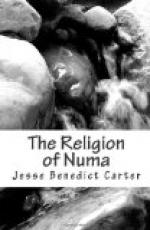but—a much more significant fact—their
Greek names were dropped, and they were given Roman
names instead, to make them seem less out of place.
Then too these Roman names were not new names, translations
of their Greek titles, but were the names of already
existing Roman deities with whom they were easily
identified, so that we see at once that their coming
was no real enrichment of the Roman Olympus; what
they stood for was already represented there, and
their coming was simply a reduplication, with the
consequent result that as these parvenus increased
in prominence and influence, they robbed of all their
vitality the sober old Roman deities to whom they
had attached themselves. What were these original
deities who were thus doomed to death in B.C. 496?
Demeter took the name of the old Roman goddess Ceres,
a goddess of fertility, about whom we know just enough
to assert that she belonged to the old religion of
Numa and that she was at heart quite a different person
from Demeter. All the rest is lost, submerged
under the new Demeter-Ceres with her temple built by
Greek architects and her April games. It is this
new Ceres who soon develops an extraordinary political
importance because her temple is to the Plebeians
as a class what the temple of Minerva is to the unions
of organised labour. It is there that they have
their meeting-place, and the temple itself is always
their treasury as contrasted with the Saturn temple,
the treasury of the state as a whole. The very
officers of the Plebeians, the famous Plebeian aediles,
get their name from association with this temple (
aedes).
This political side of her activity is the only real
advantage, except the grain itself, connected with
her importation; the two form at best a poor economic
compensation for the ever increasing immoral effects
of the public games of Ceres.
But though Ceres is the most important of the three
deities economically and politically, we must not
forget the other two, both of whom are interesting,
though one of them more for what she is not than for
what she is. Along with Demeter came Dionysos
and Demeter’s daughter Kore: the three
were associated in the solemn mysteries of Eleusis,
but none of the beauty of these ideas went over into
the Roman cult. Demeter was merely the deified
grain-traffic, and Dionysos was little else than the
god of wine, while poor Kore fell out without any particular
content for a curious reason that we shall see in
a moment. The only old Roman deity with whom
Dionysos could be identified was the god Liber, who
had had a rather interesting history, and who had
done enough along the line of self-development to
deserve a better fate than to be crushed to insignificance
under the prominence of his new namesake. Liber
was at this time a flourishing god of fertility and,
since the introduction of the grape into Italy, especially
the patron of the fruit of the vine, but he had made
his own career, and there was a time when he had no




